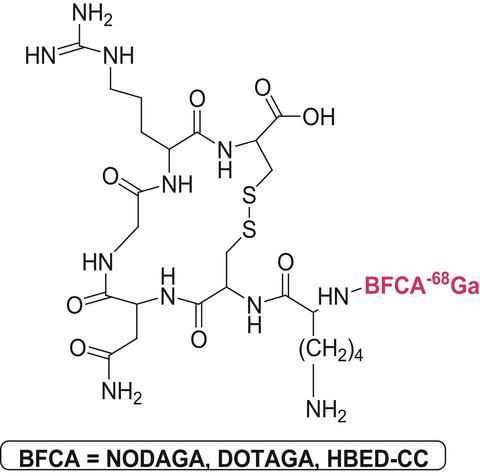当前位置:
X-MOL 学术
›
Chem. Bio. Drug Des.
›
论文详情
Our official English website, www.x-mol.net, welcomes your feedback! (Note: you will need to create a separate account there.)
Comparative evaluation of 68Ga‐labeled NODAGA, DOTAGA, and HBED‐CC‐conjugated cNGR peptide chelates as tumor‐targeted molecular imaging probes
Chemical Biology & Drug Design ( IF 3 ) Pub Date : 2017-12-06 , DOI: 10.1111/cbdd.13143 Drishty Satpati 1 , Rohit Sharma 1 , Haladhar Dev Sarma 2 , Ashutosh Dash 1
Chemical Biology & Drug Design ( IF 3 ) Pub Date : 2017-12-06 , DOI: 10.1111/cbdd.13143 Drishty Satpati 1 , Rohit Sharma 1 , Haladhar Dev Sarma 2 , Ashutosh Dash 1
Affiliation

|
The biological behavior of 68Ga‐based radiopharmaceuticals can be significantly affected by the chelators’ attributes (size, charge, lipophilicity). Thus, this study aimed at examining the influence of three different chelators, DOTAGA, NODAGA, and HBED‐CC on the distribution pattern of 68Ga‐labeled NGR peptides targeting CD13 receptors. 68Ga‐DOTAGA‐c(NGR), 68Ga‐NODAGA‐c(NGR), and 68Ga‐HBED‐CC‐c(NGR) were observed to be hydrophilic with respective log p values being −3.5 ± 0.2, −3.3 ± 0.08, and −2.8 ± 0.14. The three radiotracers exhibited nearly similar uptake in human fibrosarcoma HT‐1080 tumor cells with 86%, 63%, and 33% reduction during blocking studies with unlabeled cNGR peptide for 68Ga‐DOTAGA‐c(NGR), 68Ga‐NODAGA‐c(NGR), and 68Ga‐HBED‐CC‐c(NGR), respectively, indicating higher receptor specificity of the first two radiotracers. The neutral radiotracer 68Ga‐NODAGA‐c(NGR) demonstrated better target‐to‐non‐target ratios during in vivo studies compared to its negatively charged counterparts, 68Ga‐DOTAGA‐c(NGR) and 68Ga‐HBED‐CC‐c(NGR). The three radiotracers had similar HT‐1080 tumor uptake and being hydrophilic exhibited renal excretion with minimal uptake in non‐target organs. Significant reduction (p < .005) in HT‐1080 tumor uptake of the radiotracers was observed during blocking studies. It may be inferred from these studies that the three radiotracers are promising probes for in vivo imaging of CD13 receptor expressing cancer sites; however, 68Ga‐NODAGA‐c(NGR) is a better candidate.
中文翻译:

比较68Ga标记的NODAGA,DOTAGA和HBED-CC偶联的cNGR肽螯合物作为靶向肿瘤的分子成像探针
螯合剂的属性(大小,电荷,亲脂性)会严重影响68种基于Ga的放射性药物的生物学行为。因此,本研究旨在检查三种不同的螯合剂,DOTAGA,NODAGA和HBED-CC对68种Ga标记的靶向CD13受体的NGR肽分布模式的影响。分别观察到68 Ga‐DOTAGA‐c(NGR),68 Ga‐NODAGA‐c(NGR)和68 Ga‐HBED‐CC‐c(NGR)的亲水性,分别为log p值为-3.5±0.2,-3.3±0.08和-2.8±0.14。这三种放射性示踪剂在人纤维肉瘤HT-1080肿瘤细胞中的摄取几乎相似,在对68 Ga-DOTAGA-c(NGR),68 Ga-NODAGA-c的未标记cNGR肽进行的阻断研究期间,其放射性减少了86%,63%和33%(NGR)和68 Ga-HBED-CC-c(NGR),分别表明前两种放射性示踪剂的受体特异性更高。中性放射性示踪剂68 Ga-NODAGA-c(NGR)在体内研究中显示出比其带负电荷的对应物68 Ga-DOTAGA-c(NGR)和68具有更好的靶标与非靶标比Ga‐HBED‐CC‐c(NGR)。这三种放射性示踪剂具有相似的HT-1080肿瘤摄取,并且亲水性表现出肾脏排泄,在非靶器官中的摄取最少。 在阻断研究期间,观察到放射性示踪剂的HT-1080肿瘤摄取显着降低(p <.005)。从这些研究中可以推断出,三种放射性示踪剂是用于体内表达CD13受体的癌症部位成像的有前途的探针。但是,68 Ga‐NODAGA‐c(NGR)是更好的选择。
更新日期:2017-12-06
中文翻译:

比较68Ga标记的NODAGA,DOTAGA和HBED-CC偶联的cNGR肽螯合物作为靶向肿瘤的分子成像探针
螯合剂的属性(大小,电荷,亲脂性)会严重影响68种基于Ga的放射性药物的生物学行为。因此,本研究旨在检查三种不同的螯合剂,DOTAGA,NODAGA和HBED-CC对68种Ga标记的靶向CD13受体的NGR肽分布模式的影响。分别观察到68 Ga‐DOTAGA‐c(NGR),68 Ga‐NODAGA‐c(NGR)和68 Ga‐HBED‐CC‐c(NGR)的亲水性,分别为log p值为-3.5±0.2,-3.3±0.08和-2.8±0.14。这三种放射性示踪剂在人纤维肉瘤HT-1080肿瘤细胞中的摄取几乎相似,在对68 Ga-DOTAGA-c(NGR),68 Ga-NODAGA-c的未标记cNGR肽进行的阻断研究期间,其放射性减少了86%,63%和33%(NGR)和68 Ga-HBED-CC-c(NGR),分别表明前两种放射性示踪剂的受体特异性更高。中性放射性示踪剂68 Ga-NODAGA-c(NGR)在体内研究中显示出比其带负电荷的对应物68 Ga-DOTAGA-c(NGR)和68具有更好的靶标与非靶标比Ga‐HBED‐CC‐c(NGR)。这三种放射性示踪剂具有相似的HT-1080肿瘤摄取,并且亲水性表现出肾脏排泄,在非靶器官中的摄取最少。 在阻断研究期间,观察到放射性示踪剂的HT-1080肿瘤摄取显着降低(p <.005)。从这些研究中可以推断出,三种放射性示踪剂是用于体内表达CD13受体的癌症部位成像的有前途的探针。但是,68 Ga‐NODAGA‐c(NGR)是更好的选择。



























 京公网安备 11010802027423号
京公网安备 11010802027423号